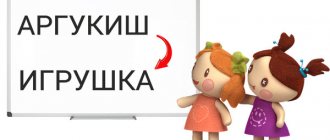At preschool age, children actively explore the world around them. In this regard, psychologists argue that in childhood a person acquires as much knowledge as he will not receive in his entire life. At the same time, the quality of acquired knowledge will depend on how fully developed the child’s mental processes (memory, thinking, imagination, perception). Among all the properties of the psyche, a special place is given to attention, without which neither mental nor intellectual activity is possible. With the right approach to education, training attention and, on its basis, mindfulness, as a personality trait, can be successfully carried out at home.
Important! Parents need to take into account that attention:
- this is a focus on the surrounding world;
- has the properties of concentration, stability, intensity, distribution, switching;
- the main type in preschool children is involuntary attention that occurs spontaneously;
- the main task is to develop voluntary attention; without it, successful schooling is impossible
Features of attention in preschool children
Attention is a mental process, the essence of which is focusing on some object or phenomenon. It can be directed both to the outside world and inside a person (to his feelings, experiences). The main properties of attention include:
- Stability (focus, concentration);
- Volume (the ability to keep several objects in focus);
- Switchability (the ability to shift the focus of attention from one object to another - at the will of a person);
- Distributiveness (the ability to distribute attention between several types of activities, for example, listening to a fairy tale and drawing at the same time).
When training your child’s attention, try to devote time to each of the listed properties of attention. After all, they are all equally important and play a big role in the assimilation of information.
Psychologists distinguish two main types of attention:
- Involuntary attention does not require volitional effort and is based on the body’s quick reaction to a strong stimulus. We always pay attention to something unusual or bright, to something that makes a strong impression (for example, a strong smell, a strange outfit of a person in a crowd, a loud sound, etc.).
- Voluntary attention presupposes the presence of volitional effort and intention. If a person has a goal and motivation to achieve it, he is able to concentrate his attention for a long time even on uninteresting and routine activities.
Stages of attention development in children:
| Age | Peculiarities |
| 0-1 year | Involuntary attention. The baby pays attention to everything bright and unusual. |
| 1-2 years | The beginning of the formation of voluntary attention. Children of this age develop a strong interest in exploration and a desire for independence. The child chooses an activity to his liking. |
| 2-3 years | Formation of the ability to follow visual instructions and complete tasks according to the model. |
| 3-4 years | Active development of auditory attention. |
| 5-7 years | Volitional attention continues to form (by the age of 7 it should be quite well developed). Increasing the volume of attention, its stability and the ability to switch attention from one object to another. |
Young children have the most developed involuntary attention. As children grow older, they learn to control their mental processes. One of the main tasks of preschool age is the development of voluntary (volitional) attention. The ability to concentrate on a task and switch from one type of activity to another is necessary for successful learning at school.
Rules for training voluntary attention
Voluntary attention is a special type; its implementation requires goal setting and volitional efforts. In preschool children, neither one nor the other has yet been developed. Parents should develop all this by teaching their preschoolers to be independent. To properly work on developing voluntary attention at home, it is necessary to follow certain rules:
- Consistency and systematicity of classes.
- Working on voluntariness is difficult for young children. To make complex activities attractive to children, you need to start with easy-to-perform exercises, gradually moving on to more complex ones.
- Training to develop voluntary attention is carried out in two positions:
- Special exercises for the basic properties of attention.
- Special tasks for developing attentiveness and eliminating attention depletion.
Games to develop attention for children 3-4 years old
In early preschool age, children's attention is not yet stable enough; it is difficult for them to concentrate on something, especially if there are distractions. The adult’s task is to select material for games that would be interesting to the child and he could concentrate on it for at least 5-7 minutes.
- “Complete the picture.” Draw objects that are missing details on a sheet of paper in advance. For example, a car without wheels, a cat without a tail, or a hare without ears. Let the child look carefully at the pictures and guess what is missing. Then the child or adult completes each picture.
- "Repeat after me". This exercise can be performed both at home and outdoors. Show your child a simple movement and ask him to repeat after you. Gradually increase the number of movements.
- "Find a match." Draw pairs of objects on paper or place them on the table. Let the baby put them in pairs.
- "Find differences". Invite your child to look at two pictures that differ from each other in several details (no more than 7). The baby must find these differences.
- “What did the artist mix up?” Draw or print a picture that shows objects in the wrong places or with the wrong details. For example, a car flies through the sky, a cat has bunny ears, fish walk on the ground, and so on. The child must show that the artist has mixed up and explain why.
For activities, choose bright and simple objects and images to interest your baby. If the child does not want to complete the task, do not insist. Please try again after some time.
CONCENTRATION STANDARDS
Concentration of attention refers to the period of time during which a person is able to maintain concentration on one action. In children, it can have a different duration depending on age, but even the number of years lived is not a fundamental factor. The norm depends on the individual characteristics of the baby. The table shows specific indicators.
| Age, years | Norm, minutes |
| 2 | 4-10 |
| 3 | 5-15 |
| 4 | 8-20 |
| 5 | 10-25 |
| 6 | 11-30 |
| 7 | 15-35 |
Indicators can be either increased or decreased, because attention, like the body and brain, can be trained with special exercises. Regular classes with a preschooler will give parents and the child a good mood, and will also be very useful for improving the ability to concentrate on something and maintain this concentration. It is necessary to develop it so that the child becomes more observant and can easily detect any small details or subtle signs. All this will further help in the learning process, since attention is closely related to memorization.
Mindfulness exercises for children 4-5 years old
Children of this age are able to concentrate on a task for 20 minutes. The amount of attention increases, the baby learns to distribute it correctly. Role-playing games, creative activities (drawing, modeling, appliqué), and performing household chores help develop attention. A 4-5 year old child can already follow the rules quite well and remember them, due to this the voluntariness of all mental processes, including attention, develops. Here are games that will help your baby become more attentive:
- "4 Elements". Give your child instructions: each of the 4 elements has its own movement. When you call the word, the baby must perform the correct movement. For example, water – arms out to the side, earth – arms down, air – arms up, fire – jump. You can come up with your own version of the game that will interest your child.
- “Heard - clap.” Call out different words and have your child listen carefully and clap their hands when they hear a word that belongs to a pre-selected category (such as animals or vegetables).
- Labyrinths. This task, beloved by all children, perfectly develops visual attention and thinking.
- "Confusion." The child must name who is depicted in the picture.
To avoid absent-mindedness and other attention disorders, do not overload your baby with too complex tasks.
TECHNIQUES FOR INCREASING ATTENTION
We have seen that developing the ability to concentrate is of particular importance for preschoolers. And parents should train their children using an unobtrusive game form. Let's highlight a few tricks and techniques that you can use.
- Maintaining interest. Using game forms, you can ensure that the child will study with great pleasure and, accordingly, attentively.
- Stick to the duration of your classes. So, when studying numbers with a 4-year-old child, you need to understand that the child is able to hold attention for no more than 20 minutes, so it is better to keep the educational material within this framework.
- Favorite characters and toys will also help you not lose interest, and therefore listen and perceive what the parent is saying.
- Show by example. You can explain to the child that if he is attentive and tries to fulfill his parents’ instructions, then the result (for example, a tower of blocks) will turn out much better than if he worked without concentration, somehow.
- Reading and attention are interconnected, so to improve the second, you can teach your child the first. While the baby is just getting acquainted with letters, the mother can read interesting fairy tales and stories to him. Afterwards, you definitely need to discuss what you read, asking to retell it, asking questions. This will help you find out how carefully the baby listened.
If the baby has trouble concentrating and is very far from his age norm, then he may have shallow breathing. Inflating balloons, soap bubbles, playing the pipe or whistle will help correct the situation. In addition, studies have proven that walks in the fresh air and active sports games are very beneficial for children.
Games and exercises for preschoolers 5-7 years old
In children of senior preschool age, the volume of attention and its stability significantly increase. By playing and being creative, they can independently plan their actions. Exercises to develop attention at this age should be based on previously acquired knowledge, skills and abilities (for example, counting, spatial orientation).
- “Repeat the pattern.” Using counting sticks or popsicle sticks, lay out a certain pattern (or a schematic image of something, a letter, a number) on the table. The child must repeat it.
- "Graphic dictation." On a checkered sheet of paper, the child must draw a pattern under dictation (for example, one cell to the left, then two cells up, three to the right, and so on).
- "Wimmelbooks." These are books with small detailed illustrations. Invite your child to find something in the picture or count the number of selected objects.
- "Color the circles." Draw ten identical circles on a piece of paper. Next, following the verbal instructions, the baby must color each circle: for example, the second circle on the right is yellow, the fifth from the left is green.
- "Look carefully." Invite your child to find as many given letters as possible on a newspaper or magazine sheet (for example, find all the letters A or M).
- "Schulte Tables". These are tables filled with numbers (from 1 to 10 or from 1 to 20) in a chaotic order. The child should try to find all the numbers in order as quickly as possible.
TYPES OF EXERCISES FOR DEVELOPMENT
The following types of attention tasks can be distinguished for 5–6 year olds.
- Repetition. The parent draws a series of 2-3 repeating figures on paper, the child’s task is to determine which one should go next and complete the series. Instead of figures, you can build rows of letters.
- Search for the superfluous. At first, the task is simple: for example, the baby is offered 10 triangles and 1 square or 5 animals and one plant. We are gradually making it more complicated: 5 garden flowers and 1 wildflower are presented.
- Find the difference. The game is well known to everyone. Two almost identical pictures are laid out in front of the child, his task is to find those details that are slightly different. The level of difficulty also varies depending on preparedness.
- A variation of the previous task - find two identical ones. The child is offered an illustration that depicts several objects, such as vases, that differ from each other in minor details. The preschooler must carefully examine the models and find two identical ones among them. In the first stages of work, it is better to use pictures with obvious differences; this will help the child gain self-confidence and reinforce his interest. Further tasks become more difficult.
- Working with pictures. There are special illustrations in which animals, such as tigers or wolves, are presented in a veiled form. You can invite your child to find them all.
- Correlation of an object and its shadow.
- Coloring by numbers. The parent gives the child a black and white picture that needs to be made in color, while the picture itself is divided into fragments, each of which is marked with its own number. A decoding of the numbers is provided separately (for example, 6 is pink, 5 is red). The child’s task is to carefully color the image without confusing the tones.
- Drawing by numbers. A very good exercise for preschoolers who are familiar with counting to one hundred, and children of primary school age. The child is offered a picture, which for now consists only of dots, next to which a number is indicated. The kid must connect them, moving in order: first find 1, then connect it with 2, and so on.
It is important to remember that training should be built according to the principle “from simple to complex.” If the child does not succeed in something, you should postpone this task and offer him a simpler option.
conclusions
In order for a child to absorb information well and be able to study successfully at school, it is necessary to devote enough time to developing his attention. When choosing games and exercises for your child, focus on his age, interests and individual characteristics. If the child does not want to complete a task or is very tired, you need to try to understand what is causing this: uninteresting material, difficulty of the task, bad mood or well-being. With the right approach, all cognitive processes of preschoolers, including attention, develop very quickly.
EXAMPLES OF SIMPLE GAMES
There are a huge number of all kinds of games and tasks that will help your child learn to concentrate and also give him a good mood. The main thing is to conduct them in a positive way; the child should not have the thought that he is being taught something. It’s better if he is sure that mom and dad are playing with him.
AUDITORY ATTENTION
“Edible – Inedible” is a simple but effective game that you can play with one child or several. Mom throws the ball, saying the name of a dish, product or inedible item, such as clothing. The child listens carefully. If he hears the name of food, then he catches the ball, but if something unrelated to cooking sounds, then he needs to hit the ball.
There are many variations, so when a child is tired of food and is bored, you can offer slightly different games.
- "It flies - it doesn't fly." The mother names animals and birds, the child, when he hears the name of a bird, raises his hands, and when he hears the name of an animal, he crouches. Over time, the task becomes more complicated - the adult names the animal and raises his hands, while the child must pay attention and sit down.
- "Harvest". Mom is reading a story, into which she will periodically insert the words “plums” and “cherries,” and not always appropriately. The child must, firstly, hear the signal words themselves, and then perform the action: for “plums”, jump, for “cherries” - stand on one leg. An important feature is that the exercise is done from simple to complex: first, when pronouncing the text, the parent uses his voice to highlight signal words, then pronounces them in a normal rhythm so that the child is more attentive.
- "Catch - don't catch." You will need two small balls - light and dark. A light child should always catch, and a dark child should only catch when his mother silently throws him. If at the same time the command “Catch” is heard, then you cannot catch.
- "Repeat the rhythm." The mother sets a simple rhythm, beating it with her palms, and the baby must repeat it.
- "Clap." This is also an interesting task, the level of difficulty of which can vary depending on the child’s preparation. The mother gives the instruction: when she claps once, the child stands on his toes, when she claps twice, on his heels, when he claps three times, he squats. The speed of the clapping gradually increases.
All these games are good because they are not tied to a specific place, they can be played almost anywhere, and the child will not have the feeling that he is being taught something, he will have fun and interesting.
SERIES OF TASKS
The child is given instructions to complete several tasks (you need to start with three, gradually increasing their number), while all tasks are listed at once, so the child will have to remember both the actions themselves and their order. For example:
- Jump 7 times.
- Bring the red item.
- Name a garden flower.
If the child did everything correctly, you should definitely praise him, but if something didn’t work out, correct him, but in a soft, delicate manner. Gradually the number of tasks and their complexity increases; such an exercise will also help improve memory.
OTHER EFFECTIVE GAMES
It is very important to constantly offer the preschooler something new, so that he gets the impression of a game, and not a useful activity. For example, "Dwarfs and Giants". The idea is simple: mom names an object, it must be either large (mountain, skyscraper, multi-story building, whale, elephant) or small (needle, button, coin, bead). The child listens, when a word from the “big” series is pronounced, that is, “giant,” he stands on his toes and raises his straight arms up, when the “small” one, he crouches.
If there are several children, you can play “Broken Phone”. To do this, all participants sit in a row, the first whispers a word in the ear of the second child, who passes it on to the third, and so on. The latter listens to the word and pronounces it out loud; if it matches the original version, then the phone works, but if not, it is broken.
“Guess where the woodpecker is.” An adult knocks, imitating the knock of a woodpecker, sometimes loudly (the bird is close), sometimes quietly (far away). The baby’s task is to tell where exactly the woodpecker is located.
VISUAL ATTENTION
There are a large number of exercises that will help improve visual concentration, and you can play in any convenient place - at home, on a walk, on the way to your grandmother. They are simple, do not require any preparation, and are effective.
- Search for an item. The mother describes some object that is in the room (outside), the child must find it with his eyes and name it.
- "Look at me". The child examines his mother, her outfit, hairstyle, and accessories for a few seconds. Then he turns his back to her and answers questions like “what color is my bag”, “am I wearing a lilac jacket”, “do I have a brooch”? The main thing is to formulate questions so that the child has a chance to answer them. You can make the work more complicated: the child looks at his mother, tries to remember the details of her costume, after which she changes something in her appearance, for example, takes off her scarf. The baby must remember the previous image and report what changes have happened to him. The game is played on the principle of increasing complexity: at first the change is obvious, then, when it becomes easier to achieve the required concentration of attention, the details are chosen to be less significant. For example, a mother can remove the ring from one finger and put it on the other, or make two changes to her image (of course, the child must be warned about this).
- Working with a picture. Very similar to the previous task. The child is given a picture that he has not seen before. He should try to remember as many details as possible. After this, the illustration is removed and the baby is asked a series of questions.
- Graphic task "Beetle". The parent draws a sheet of paper in advance to make cells. Places a beetle figurine in one of them. Then he gives the task - listening to his prompts, move the insect. For example: two cells to the right - then one down - now three to the left and one up. Then the task becomes more complicated: mom immediately names several moves: cell down - two to the left - three up. The child must follow the direction with his eyes and place the beetle in the last cell. You can't move your finger.
- Another good exercise is “Cross out the letter.” The mother gives the baby a text, as well as a task - to find all the letters in it, for example, L and cross them out. When this works out well, you can make it more complicated: find A and L, cross out L with one line, and cross out A with two.
- “Do it as it was.” The figures are laid out in front of the child in a certain sequence. These can be buttons of different colors and colors, toy dishes, cards with images. The child tries to remember the sequence, then turns away, and the mother swaps some two objects. Turning around, the baby must say where the changes occurred.
Games to develop attention should be carried out regularly, only in this case can a positive effect be expected from them. Among the many exercises, you can choose those that your baby likes most and turn to them.





